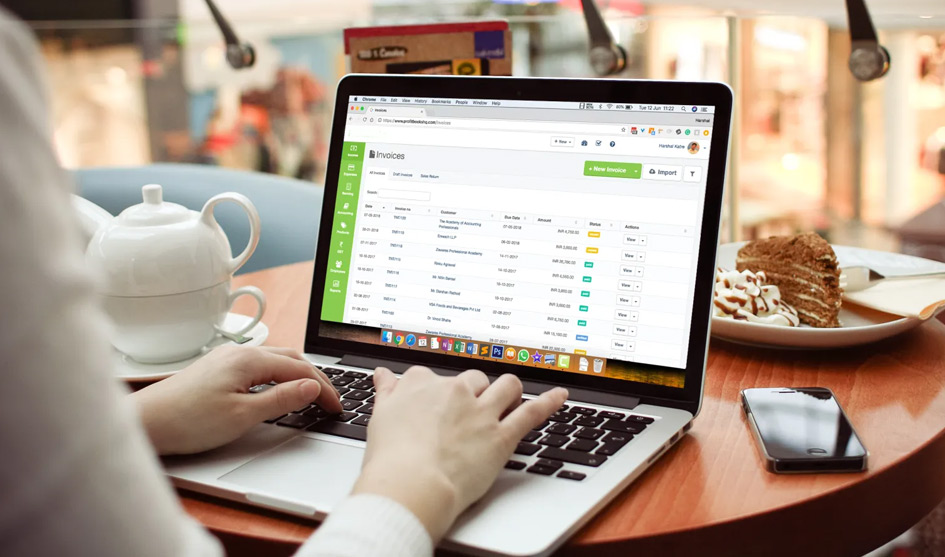Accounting experts are often divided on the cloud. Accountants are migrating to the cloud at a rapid pace, recognising the benefits of increased mobility and easier client collaboration. These are vital if you want to create a long-lasting practice.The majority of accounting professionals agree that cloud computing is the way of the future. Almost everyone agrees to the fact that there is no clear 'best practise' guide for migrating accountants and their clients to the cloud.
It's not easy to go from traditional accounting practice to a modern one that benefits from the cloud's productivity-boosting advantages. As an accountant, you’re not only moving yourself and software to the cloud; you're also redefining how you work and interact with those clients. While it is true that your work as an accountant would be more efficient once it is fully operational in the cloud, you must first get there.
What is Cloud accounting software, and how it works for accountants?
Whether you're aware of it or not, you're probably already using cloud technology on a daily basis. For example, perhaps you use Dropbox or ShareFile to exchange files, or perhaps you use cloud-based office software such as Google Apps or Microsoft Office 365. Any system that enables remote access to your data is a cloud system.
Cloud accounting software operates in a similar manner. You use it in the same way as any other accounting software, with one major difference. The data associated with your clients' accounts are not saved on your own computer, where it may be lost, stolen, or unintentionally destroyed. Rather than that, it is securely kept remotely on secure servers.This means you may access it from any computer, smartphone, or tablet at any time. This reduces your IT costs as well and ensures that you always have the most secure version of the software.
How can cloud accounting software increase your revenue?
Cloud accounting can help accountants run a more efficient business. It enables you to more easily – and affordably – provide basic accounting services. This frees you to focus on more profitable tasks such as advisory services, consulting, and new business development.
Accountants that use a fixed-fee pricing model typically benefit the most from cloud migration. They significantly reduce the time required for traditional services such as bookkeeping, accounting, and tax preparation. They can then add clients and projects while maintaining the same level of staffing.
All of this can help you strengthen your position as the most trusted accountant and a financial and business management advisor to your clients. Rather than simply preparing financial statements and correcting data errors, with the help of cloud accounting software, you can:
- Explain the true meaning of the numbers.
- Provide financial direction.
- Provide business advice.
- Develop growth strategies.
- Identify the problems.
To begin the process of moving your practice to the cloud, review the three critical steps outlined below –
Step 1 - Start using cloud-based solutions
Hands-on experience is the best way to learn any new technology, and cloud accounting is no exception. A good way to evaluate cloud accounting software is to use a sample of your firm's internal financial records. Because you already know what to expect from the data, you'll be able to quickly determine whether the numbers add up.
A good cloud accounting software provider will enable you to create a free trial. Enter your data into the trial account to ensure that the software is properly handling basic accounting. Then you can make a comparison between the cloud software and your current accounting system.
Consider any significant distinctions between the two systems, such as ease of use, workflow, and terminology. Begin by performing a basic run-through and asking yourself questions such as -
- What’s different?
- What’s new?
- Can I do everything that I could with the old software?
- Do I have to manage myself differently? If so, is it easier or more difficult?
- Is there any way I can streamline my work?
- What tools are available to assist in automating routine tasks?
Step 2 – Identify the benefits
As an accountant, once you've mastered the fundamentals of the software, you can conduct a more in-depth evaluation and consider how you'll use it. Consider the following:
- Which of my clients would benefit from this software?
- Which clients would be inappropriate – and why?
- Is this technology capable of enhancing client relationships?
- Can I use this software to collaborate more closely with my clients?
- Will it encourage my clients to take a more active role in their account management?
Bear in mind that learning new software takes time. However, implementing more effective and productive processes will significantly benefit your practice, so keep an open mind.
Step 3 – Identify ideal clients
Once you've gained confidence in using cloud accounting software, you can begin implementing it for some of your clients. Make prudent selections to ensure that the migration process is as simple and straightforward as possible.
Small businesses and self-employed individuals are ideal candidates for a cloud pilot project, as the migration process should be relatively straightforward. Additionally, young, tech-savvy businesses that leverage mobile technology are excellent candidates. That is because they are already aware of the advantages of cloud computing. Professional, creative, and online businesses frequently fit both of these criteria, making them ideal candidates for the initial cloud migration.
However, clients with significant inventory, complex software integrations, or a high volume of transactions should be avoided. The process of migrating such clients to the cloud will be more complicated. It's much easier to do once you've gained complete confidence in your cloud accounting software of choice.If none of your current clients appears to be a good fit, consider your most cost-conscious clients. You can sell them on a cloud-based system as a cost-effective alternative to a desktop product, as they will only be paying a small monthly subscription fee. You could even combine the subscription fee and your service fees into monthly invoices. This way, they will avoid receiving large bills throughout the year.
The cloud may even assist you in retaining clients that you were considering releasing. At times, it's necessary to terminate a client relationship for the sake of profitability, time, or even your own sanity. However, the cloud may end up being the deciding factor in preserving and enhancing the relationship.
Step 4 – Setup, convert and learn
As you migrate your first group of clients to the cloud, it's critical to assess what works and what doesn't. Make an attempt to learn from the transition process and determine your next course of action. Consider the following:
- What was effective and what was ineffective? Why?
- Which features did my clients take advantage of? What did they regard as valuable?
- What features did my clients overlook? What were they struggling with?
- Where did efficiencies occur? How can I improve my usage of these?
- How can I earn my client's trust as a trusted advisor?
Additionally, you should consider your role in the migration process. More precisely:
- Are you capable of managing the process effectively?
- Effective communication?
- Collaborate effectively with your clients?
- Are you properly training your clients so that they can use the new solution from the start?
Finally, don't forget to inquire about the client's benefits from moving to the cloud:
- Are they satisfied with the software's performance and effectiveness?
- Are they more invested in your relationship?
- Do they believe they have the confidence to put a more active role in their financial lives?
- Do they have better access to more accounting workflows?
Problems with traditional accounting software
- The system's data is not always up to date.
- It is limited to a single computer, and data is transferred via external storage, such as a USB drive. This is not a secure or reliable method of communication.
- Backups are expensive and complicated to maintain (if they are done at all).
- User access is restricted to a single individual. Financial and customer information is not accessible to key people.
- In comparison to cloud accounting software, which updates automatically, upgrading is costly, difficult, and time-consuming.
Benefits of Cloud accounting software
As an accountant, managing your client’s business accounts online has several benefits –
- Data about your client’s sales, income and purchases can be transferred directly from their bank to their books, saving you hours of transcribing time.
- As an accountant, you can view the current financial position of your client’s company within a few minutes.
- The ability to collaborate online with your clients is made simple by multi-user access functionality.
- There is nothing to install or update as it is cloud-based software, and your entireclient’s data is automatically backed up.
- As an accountant, you can create a dashboard that displays critical financial information of your clients,such as who owes them money, when their bills are due and the state of their cash flow.












